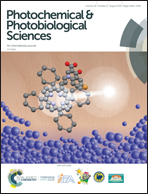Self-assembly of porphyrin on graphene oxide in aqueous medium: fabrication, characterization, and photocatalytic studies†
Abstract
We herein report the supramolecular self-assembly of a water soluble porphyrin, namely, 5,10,15,20-tetrakis(1-methyl-4-pyridinio)porphyrin-tetra(p-toluenesulfonate) (TMPyP), on the surface of graphene oxide (GO). The fabricated GO nanosheet and GO@TMPyP hybrid material composite have been characterized by using various spectroscopic and analytical techniques, e.g., scanning electron microscopy (SEM), X-ray diffraction (XRD), transmission electron microscopy (TEM), and Fourier transform infrared (FT-IR) spectroscopy. The steady state absorption measurements of the GO@TMPyP self-assembly showed a significant red shift (∼20 nm) compared to those of the control TMPyP in water. The steady state fluorescence measurements showed a significant fluorescence quenching of the singlet excited state of TMPyP in the presence of GO. These findings suggest the electron transfer reaction from TMPyP to GO. The time resolved fluorescence measurements showed a considerable decrease in the lifetime of the singlet state of TMPyP in the presence of GO, from which the rate and efficiency of the electron transfers from TMPyP to GO were determined to be 1.93 × 109 s−1 and 91%, respectively. The transient absorption measurements showed a considerable quenching of the triplet excited state of TMPyP in the self-assembly. All these findings confirm the occurrence of efficient electronic interactions between TMPyP and GO in both the ground and excited states. In addition, the fabricated GO@TMPyP showed high photocatalytic activity for the degradation of methylene blue (MB) and methyl orange (MO) mixed dye pollutants in water under visible light irradiation.



 Please wait while we load your content...
Please wait while we load your content...